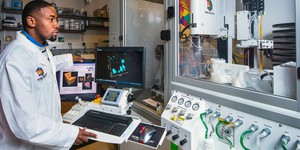Log In
Summary
*Note:
For this science project you will need to develop your own experimental procedure. Use the information in the summary tab as a starting place. If you would like to discuss your ideas or need help troubleshooting, use the Ask An Expert forum. Our Experts won't do the work for you, but they will make suggestions and offer guidance if you come to them with specific questions.
If you want a Project Idea with full instructions, please pick one without an asterisk (*) at the end of the title.
If you want a Project Idea with full instructions, please pick one without an asterisk (*) at the end of the title.
Abstract
Does adhesive tape hang tight at different temperatures? Measure the adhesive strength of tape at both low and high temperatures. To raise the temperature, we suggest using a blow dryer at both low and high heat settings. To lower the temperature, use an ice pack (try to keep condensation from forming on the tape and confounding the results). For even lower temperatures you could try "dry ice" (frozen carbon dioxide), if available. (Wear heavy gloves when handling dry ice, because it can rapidly freeze your skin.) A possibility for measuring the high and low temperatures is to use a digital multimeter with a temperature probe. There are many relatively inexpensive models available with this function. Use multiple tape samples at each temperature to assure yourself that your results are consistent. Try different kinds of tape. Do all tape adhesives behave similarly at different temperatures? (Foo, 2004)Bibliography
Foo, F., 2004. "Project S.T.A.T.: Scotch Tape, Adhesion, and Temperature," California State Science Fair Project Abstract [accessed April 26, 2006] http://cssf.usc.edu/History/2004/Projects/J1115.pdf.Ask an Expert
Do you have specific questions about your science project? Our team of volunteer scientists can help. Our Experts won't do the work for you, but they will make suggestions, offer guidance, and help you troubleshoot.
Global Connections
The United Nations Sustainable Development Goals (UNSDGs) are a blueprint to achieve a better and more sustainable future for all.
This project explores topics key to Industry, Innovation and Infrastructure: Build resilient infrastructure, promote sustainable industrialization and foster innovation.
Careers
If you like this project, you might enjoy exploring these related careers:
Career Profile
What makes it possible to create high-technology objects like computers and sports gear? It's the materials inside those products. Materials scientists and engineers develop materials, like metals, ceramics, polymers, and composites, that other engineers need for their designs. Materials scientists and engineers think atomically (meaning they understand things at the nanoscale level), but they design microscopically (at the level of a microscope), and their materials are used macroscopically…
Read more
Related Links
Cite This Page
General citation information is provided here. Be sure to check the formatting, including capitalization, for the method you are using and update your citation, as needed.MLA Style
Science Buddies Staff.
"Need Help Getting Out of a Sticky Situation?" Science Buddies,
28 July 2017,
https://www.sciencebuddies.org/science-fair-projects/project-ideas/MatlSci_p031/materials-science/adhesive-tape-temperature?class=AQUJkXy2x51l9tfz-KweT0o7q-sSW4FExEUXqJyQS6qqmRzeg8GzvPKvmOcbY1qJ--Krh1twH93gpdJ-Htuo0XcgTQ9xISPEIez65V0dRy1QjA.
Accessed 18 Apr. 2024.
APA Style
Science Buddies Staff.
(2017, July 28).
Need Help Getting Out of a Sticky Situation?
Retrieved from
https://www.sciencebuddies.org/science-fair-projects/project-ideas/MatlSci_p031/materials-science/adhesive-tape-temperature?class=AQUJkXy2x51l9tfz-KweT0o7q-sSW4FExEUXqJyQS6qqmRzeg8GzvPKvmOcbY1qJ--Krh1twH93gpdJ-Htuo0XcgTQ9xISPEIez65V0dRy1QjA
Last edit date: 2017-07-28
Explore Our Science Videos
Valentine's Day Candy Delivery Robot
Make Fake Snow - Craft Your Science Project
Colorful Melting Ice Ball Patterns - STEM Activity








